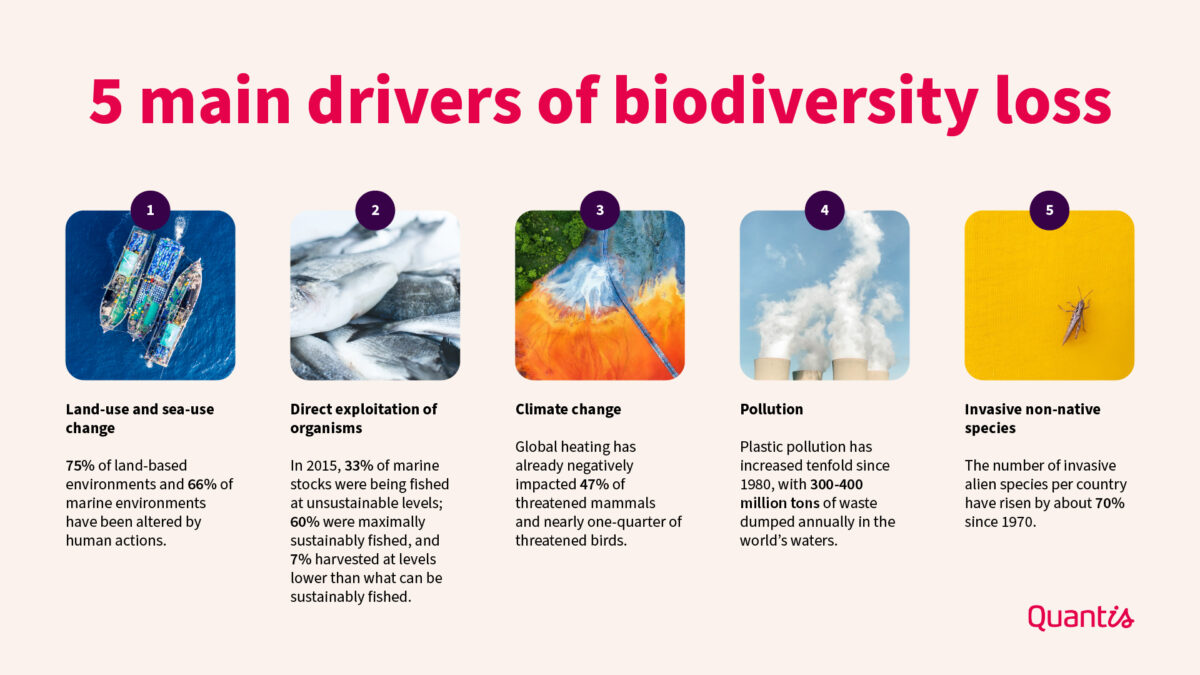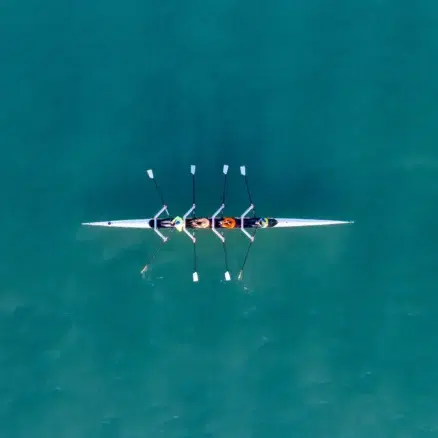In brief:
- Nature generates US$150 trillion annually in the form of ecosystem services.
- Many business activities, particularly those related to resource extraction and cultivation, are major drivers of biodiversity loss.
- If businesses fail to rein in biodiversity loss, they’ll have to brace themselves for massive disruptions to their operations, supply chains and the economy as a whole.
- Companies that take action on climate change and biodiversity loss are better positioned to mitigate major physical, regulatory, reputational and market risks.
Nature and business go hand in hand: More than half of global GDP — a whopping US$ 44 trillion — depends on nature and its services. This portion of GDP underpins the base of Maslow’s hierarchy of needs (the most fundamental necessities like food, water, shelter and clothing) — meaning that without it, the entire pyramid collapses. Yet, its value is often overlooked, with companies focusing the bulk of their efforts on cutting carbon emissions.
Tackling the climate crisis is critical — 19% of global GDP will take a hit by 2049 if nothing is done to address it. But if businesses fail to rein in biodiversity loss they’ll have to brace themselves for massive disruptions to their operations, supply chains and the economy as a whole.
But it’s not an “either-or” situation. It’s “both-and.” Climate change and biodiversity loss are two sides of the same coin; they’re intertwined through mechanistic links and feedbacks. Action taken to address one could have synergies and trade off effects on the other. Climate change exacerbates risks to biodiversity, while nature preservation is key for climate mitigation and adaptation.
Which is exactly why companies that set integrated environmental strategies that address both climate change and nature are better positioned to mitigate major physical, regulatory, reputational and market risks and realize the best versions of their business.
An interconnected web of everything
Nature is the most complex feature of our planet and it’s the most essential. But when we talk about biodiversity, what are we actually describing?
Put simply, nature is “the phenomenon of the physical world collectively.” It refers to plants, animals and other products of the earth, separate from humans and human creations.
The world’s stocks of natural assets are our natural capital — from forests and rivers to the soil and the air that we breathe — and the benefits we derive from them are ecosystem services. These services range from raw materials and food to animals and microorganisms that provide essential “regulating services,” such as pollination and water purification. Together, they provide the foundation of our economies and human life.
Nature is the foundation of the healthy ecosystems we rely on for the air we breathe, the food we eat, the medicines we need for physical and mental health, the clothes we wear and much, much more.
And here lies the problem: Nature loss — the loss of life on Earth at various levels, ranging from declines in the number, genetic variability and variety of species to the collapse of entire ecosystems — is in free fall. Experts believe we’re in the midst of a sixth mass extinction. And it’s happening at a rate 10 to 100 times faster than the extinction event that led to the dinosaurs’ demise. The shift, however, is subtle; the impacts become glaringly clear when it’s already too late. That bodes badly for people, planet and business.
Big risks and high stakes
The nature crisis is a business crisis. Biodiversity underpins the global economy, generating economic value in the form of ecosystem services worth over US$ 150 trillion annually. Yet, many business activities are also major drivers of biodiversity loss — particularly those tied to resource extraction and cultivation. And here’s what that means: Companies are effectively undermining their own resilience and contributing to the demise of their very businesses. Loss of biodiversity and ecosystem services can push up costs, heighten risks and cause performance to take a nosedive. We’re already seeing this play out; decline in ecosystem functionality costs the global economy trillions every year in the form of lost natural resources.
The OECD has identified a cornucopia of risks for companies that put biodiversity on the backburner:
- Operational (i.e., supply chain disruption or deteriorated supply)
- Liability
- Regulatory
- Reputational
- Market (i.e., changes to consumer preferences)
- Financial
In Europe, big regulatory changes are already underway that could shake things up for businesses, sooner rather than later. Central to these changes is the EU Green Deal, which is gradually being implemented and includes a comprehensive strategy to promote nature-based solutions. Additionally, the Taskforce on Nature-related Financial Disclosures (TFND) has recently finalized and released its recommendations on nature-related risk management and disclosure. This is a pivotal development designed to help businesses and financial institutions globally identify, assess, manage and report on nature-related risks and opportunities. It’s poised to become a crucial tool for investors, akin to the Task Force on Climate-Related Financial Disclosures (TCFD), helping them steer clear of investments that are heavily involved in fossil fuels — which are at risk of becoming obsolete.
The TNFD has also announced a significant list of early adopters for its reporting framework, signifying a proactive approach by over 320 organizations across nearly 50 countries to integrate nature-related risks and opportunities into their strategic and operational frameworks. Given the scale and diversity of the companies involved, this move by the TNFD and its early adopters is a strong signal of the increasing recognition of nature-related risks as critical business concerns. It reflects a growing understanding within the corporate world of the financial and strategic importance of sustainability and nature preservation.
The Corporate Sustainability Reporting Directive (CSRD) is also well underway, with its implementation significantly progressing in 2024. The CSRD mandates comprehensive sustainability reporting for large companies and listed SMEs within the EU, aiming to standardize disclosures related to environmental, social and governance (ESG) impacts. These standards are designed to improve transparency, allowing investors and stakeholders to make better-informed decisions regarding sustainability matters.
The outcomes of COP15 – the 15th meeting of the Conference of the Parties to the UN Convention on Biological Diversity –in 2022 set forth new, robust guidelines for the protection of biodiversity. These include commitments to significantly reduce habitat loss, mitigate invasive species and integrate biodiversity preservation into institutional practices. Following the conference, stricter rules on commercial land use were set forth, along with an overhaul of subsidy systems and the introduction of a slew of new taxes and fines focused on environmental conservation. The focus of 2024’s COP16 expands the following areas:
- Implementing the Kunming-Montreal Global Biodiversity Framework;
- Aligning National Biodiversity Strategies and Action Plans (NBSAPs) with the framework;
- Accelerating resource mobilization for the framework; and
- Finalizing and operationalizing the multilateral mechanism for benefit-sharing.
Tackling biodiversity loss is more than just an opportunity to “do good” — it’s an imperative for business survival.
Turning crisis into opportunity
The good news is that it’s not all bad news. It’s not too late to reverse the trend of nature loss. Companies that act now to align their business models and practices with nature can seize major opportunities to: mitigate supply chain risks, generate cost savings, increase their market share, boost their value proposition and profitability, create new operational synergies, and foster trust with consumers and investors — who are taking note of brand owners delaying action on nature.
Perhaps most importantly, by prioritizing nature, companies can make significant headway on other critical and interrelated environmental topics, which also happen to be the primary drivers of biodiversity loss:
- Land-use and sea-use change
- Resource overexploitation
- Climate change
- Pollution
- Invasive species and other disturbances

Tackling nature loss is a massive undertaking, but it’s feasible and can yield some pretty amazing results. Yacouba Sawadogo, a farmer from Burkina Faso and winner of the 2018 Right Livelihood Award and 2020 UNEP Champions of the Earth award, provides an example of what’s possible. Known as “the man who stopped the desert,” Sawadogo modified a traditional cultivation technique called Zaï (growing crops in pits that trap rainfall and filling them with organic matter during the dry season) in the 1980s to regenerate soil during a period of severe drought that led to lower productivity and yields, and as a result, devastating famine. Using his modified Zaï method, he was able to improve the soil quality and crop yield significantly, and has since created a 40-hectare forest on what four decades ago was degraded, barren land. The forest now has more than 60 species of bushes and trees, as well as an abundance of wildlife.
Aligning business with nature
So, what can companies and brand owners do to nature preservation? Transform the way they do business. Here’s how to get started:
1. Understand your reliance and impact on nature.
Knowing where to start is half the battle. You can’t begin to tackle nature loss effectively until you know how your business impacts it. And it’s not enough to consider owned operations, companies also need to look at the operations of their suppliers and how consumers use and dispose of their products and services.
The Science Based Targets Network (SBTN) released Science Based Targets for Nature in 2023, with Steps 1 and 2 focusing on assessing the environmental materiality of company activities and prioritizing areas to act. SBTN’s methodology provides companies with a big picture view of their impacts across the entire value chain, allowing them to identify the commodities and activities putting the most pressure on nature, as well as the locations and ecosystems they concern.
Companies in land-based industries, in particular, should take note. Agriculture and food production are the primary causes of biodiversity loss worldwide. Agricultural intensification has resulted in large-scale losses of nature and ecosystem services, as well as the widespread homogenization of plant diversity. This all leaves businesses incredibly vulnerable to supply chain disruptions related to climate change and its impacts.
But it’s not just agriculture for which biodiversity has become a material issue — nature is a finite and fragile resource that all businesses need. The impacts of nature loss will be felt by businesses across sectors – including cosmetics and fashion, which rely on nature for their products and packaging. Understanding your impacts and dependencies will help you determine which issues to prioritize, set meaningful objectives, develop a science-driven strategy and deploy a subsequent plan of action.
2. Set an integrated environmental strategy.
Nature doesn’t exist in a vacuum. Everything is interrelated and interdependent. Companies with separate strategies for critical environmental topics are missing out on opportunities to drive real progress and running the risk of creating unintended trade-offs. To reverse nature loss, businesses must take a systems approach, addressing climate change and land-use change — two of the main drivers of nature loss — as well as water scarcity and ocean pollution.
While nature loss can be felt globally, it requires a local perspective to make the maximum positive impact; the obstacles felt in one region of the world won’t necessarily be felt elsewhere. For example, while a company can set a global water strategy, they’ll need to understand the specific impacts and dependencies of the water basins they utilize to take appropriate action.
An integrated environmental sustainability strategy that sets objectives for not only climate change but also other nature topics and is aligned with business strategy better positions businesses to maximize their positive impact while minimizing trade-offs.
Defining mechanisms to track and measure progress is vital to keep up momentum, ensure the effectiveness of efforts and initiatives, and monitor the long-term impact on ecosystem health. Companies should publicly disclose information about its progress, making it available to investors, regulators and consumers through the appropriate channels, to foster trust and mitigate reputational and regulatory risks.
3. Build a strong foundation for success.
An ambitious, science-driven strategy isn’t enough if you don’t have the internal structures and mechanisms in place to put it into action.
Businesses that make climate and nature topics everybody’s business — not just the sustainability team’s responsibility — can expect to see big returns on their investment, while those that stick to the status quo are more likely to see their strategies flounder. Creating the ideal conditions for your integrated environmental strategy to thrive requires:
- Engaging internal and external stakeholders (including suppliers, investors and board members) about the importance of nature and providing them with training and tools that will allow them to integrate nature-supportive actions into their day-to-day and decision-making processes; and
- Holding everyone accountable for nature outcomes by setting departmental targets and KPIs.
Regardless of industry, geography or position in the value chain, businesses have an essential role to play in reversing the trend of nature loss and enhancing ecosystem vitality — and a lot to lose from apathy. It’s time to translate intention into action and align companies’ operations with nature to safeguard the future of people, planet and business.




